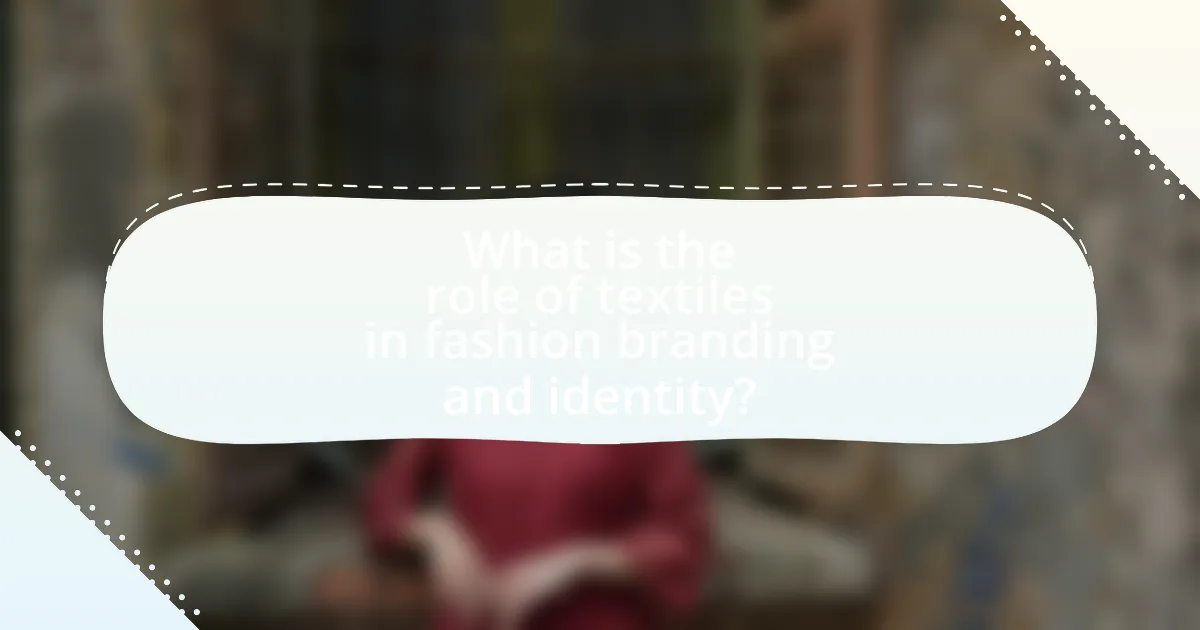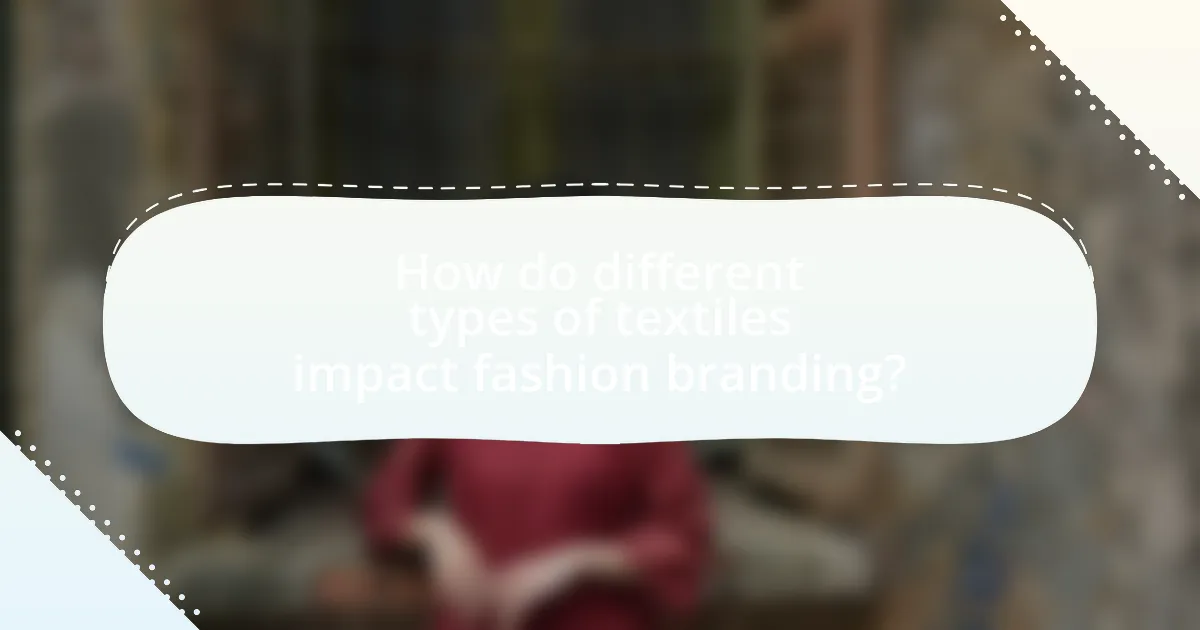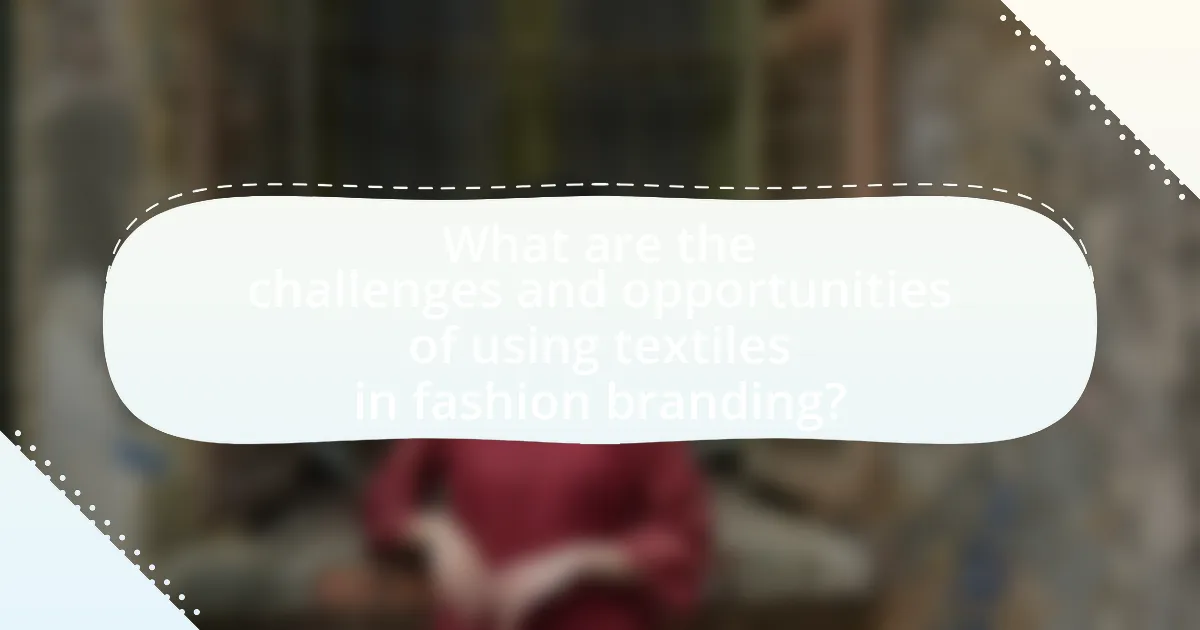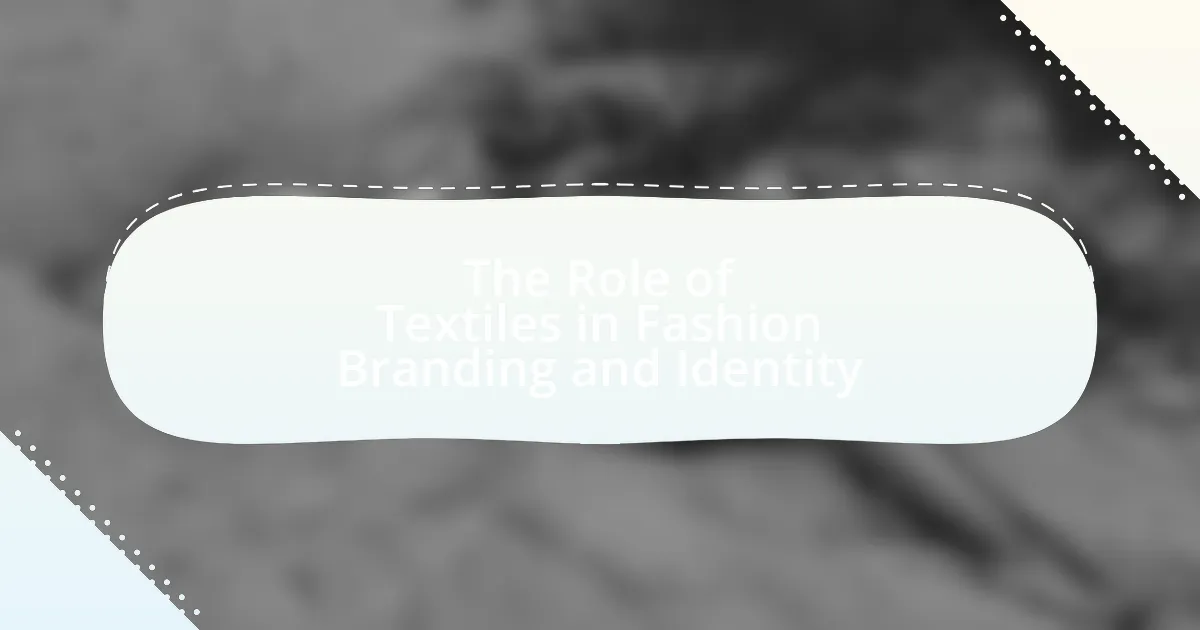The article examines the critical role of textiles in fashion branding and identity, highlighting how fabric choices influence consumer perception and emotional connections to brands. It discusses the impact of textile characteristics such as texture, color, and sustainability on brand identity, as well as how consumers associate specific materials with particular brands. The article also explores historical contexts, market trends, and the challenges and opportunities brands face in textile selection, emphasizing the importance of sustainable practices and innovative materials in shaping brand reputation and consumer loyalty. Overall, it underscores textiles as a vital element in differentiating fashion brands and communicating their core values.

What is the role of textiles in fashion branding and identity?
Textiles play a crucial role in fashion branding and identity by serving as the primary medium through which brands communicate their aesthetic, values, and market positioning. The choice of fabric, texture, and pattern directly influences consumer perception and emotional connection to a brand. For instance, luxury brands often utilize high-quality materials like silk or cashmere to convey exclusivity and sophistication, while sustainable brands may opt for organic cotton or recycled fabrics to reflect their commitment to environmental responsibility. This strategic use of textiles not only differentiates brands in a competitive market but also reinforces their identity, as seen in the case of brands like Stella McCartney, which emphasizes eco-friendly textiles to align with its brand ethos.
How do textiles influence brand perception in the fashion industry?
Textiles significantly influence brand perception in the fashion industry by conveying quality, sustainability, and aesthetic appeal. High-quality fabrics often enhance a brand’s reputation, as consumers associate premium materials with luxury and durability. For instance, brands like Chanel and Gucci utilize silk and cashmere to reinforce their high-end image, leading to increased consumer trust and loyalty. Additionally, the growing emphasis on sustainable textiles, such as organic cotton and recycled materials, shapes consumer perceptions towards brands that prioritize environmental responsibility, as seen with companies like Patagonia. This alignment with ethical practices can enhance brand loyalty and attract a conscientious consumer base. Thus, the choice of textiles directly impacts how consumers perceive a brand’s identity and values.
What characteristics of textiles contribute to brand identity?
Textile characteristics such as texture, color, pattern, and material composition significantly contribute to brand identity. Texture influences the tactile experience and perceived quality, while color evokes emotional responses and associations, reinforcing brand messaging. Patterns can create visual recognition and differentiate a brand in a crowded market. Additionally, the choice of material, whether sustainable or luxurious, communicates brand values and target demographics. For instance, brands like Patagonia emphasize eco-friendly textiles to align with their environmental ethos, enhancing their identity as a sustainable choice in fashion.
How do consumers associate specific textiles with certain brands?
Consumers associate specific textiles with certain brands through a combination of brand identity, marketing strategies, and sensory experiences. For instance, luxury brands often utilize high-quality fabrics like silk or cashmere to convey exclusivity and sophistication, which reinforces their brand image. Research indicates that consumers develop preferences based on tactile experiences and visual cues; a study published in the Journal of Fashion Marketing and Management found that 70% of consumers reported that the feel of a fabric significantly influenced their perception of a brand’s quality. This sensory connection, combined with consistent branding efforts, leads to strong associations between particular textiles and the brands that use them.
Why are textiles considered a vital element in fashion branding?
Textiles are considered a vital element in fashion branding because they directly influence consumer perception and brand identity. The choice of fabric, texture, and pattern can evoke specific emotions and associations, shaping how a brand is perceived in the marketplace. For instance, luxury brands often use high-quality textiles like silk or cashmere to convey exclusivity and sophistication, while sustainable brands may opt for organic cotton or recycled materials to emphasize their commitment to environmental responsibility. This strategic use of textiles not only differentiates brands but also reinforces their core values and messaging, making textiles essential for effective branding in the fashion industry.
What historical context shapes the relationship between textiles and fashion branding?
The historical context that shapes the relationship between textiles and fashion branding is rooted in the evolution of textile production and its influence on consumer identity. The Industrial Revolution in the 18th and 19th centuries marked a significant shift, as mechanized textile manufacturing allowed for mass production, making fabrics more accessible and affordable. This accessibility enabled brands to create distinct identities through unique textile choices, such as silk for luxury and cotton for everyday wear.
Additionally, the rise of fashion houses in the late 19th and early 20th centuries, exemplified by figures like Coco Chanel and Christian Dior, further solidified the connection between specific textiles and brand identity. These designers utilized innovative fabrics and techniques to establish their brand’s aesthetic, influencing consumer perceptions and desires. The introduction of synthetic fibers in the mid-20th century also transformed branding strategies, allowing brands to market textiles based on performance and versatility, thus shaping consumer preferences.
Overall, the interplay between textile innovation and branding strategies has historically defined how fashion brands communicate their identity and value to consumers.
How do textiles communicate brand values and messages?
Textiles communicate brand values and messages through their material, design, and production processes. The choice of fabric can reflect sustainability, luxury, or functionality, aligning with a brand’s identity; for example, organic cotton signifies eco-friendliness, while silk may convey luxury. Additionally, design elements such as patterns, colors, and textures can evoke specific emotions and associations, reinforcing brand narratives. For instance, a brand that uses bold, vibrant colors may position itself as youthful and energetic, while muted tones might suggest sophistication. Furthermore, ethical production practices, such as fair trade or local sourcing, can enhance a brand’s reputation and resonate with socially conscious consumers, thereby effectively communicating its core values.

How do different types of textiles impact fashion branding?
Different types of textiles significantly impact fashion branding by influencing consumer perception, brand identity, and market positioning. For instance, luxury brands often utilize high-quality fabrics like silk and cashmere to convey exclusivity and sophistication, which enhances their brand image and attracts affluent consumers. In contrast, sustainable brands may focus on organic cotton or recycled materials to appeal to environmentally conscious shoppers, thereby aligning their branding with ethical values. Research indicates that 70% of consumers consider fabric quality when making purchasing decisions, highlighting the direct correlation between textile choice and brand perception. Thus, the selection of textiles is a critical factor in shaping a brand’s identity and its connection with target audiences.
What are the various types of textiles used in fashion branding?
Various types of textiles used in fashion branding include cotton, silk, wool, polyester, and denim. Cotton is widely favored for its breathability and comfort, making it a staple in casual wear. Silk is known for its luxurious feel and sheen, often used in high-end fashion to convey elegance. Wool provides warmth and durability, commonly found in outerwear and knitwear. Polyester is valued for its versatility and resistance to wrinkles, frequently used in activewear and affordable fashion. Denim, a sturdy cotton twill fabric, is iconic in casual and streetwear, symbolizing a laid-back lifestyle. Each textile plays a crucial role in defining brand identity and consumer perception in the fashion industry.
How does the choice of textile affect the overall brand image?
The choice of textile significantly influences the overall brand image by conveying quality, sustainability, and style. High-quality textiles can enhance perceptions of luxury and craftsmanship, while sustainable materials can align a brand with eco-conscious values, appealing to environmentally aware consumers. For instance, brands like Stella McCartney utilize organic cotton and recycled materials to reinforce their commitment to sustainability, thereby enhancing their brand image as responsible and innovative. Conversely, the use of low-quality textiles can lead to negative perceptions, suggesting a lack of attention to detail and care in product development. Thus, the textile choice directly impacts consumer trust and brand loyalty, shaping the overall identity of the brand in the competitive fashion market.
What role do sustainable textiles play in modern fashion branding?
Sustainable textiles play a crucial role in modern fashion branding by enhancing brand reputation and appealing to environmentally conscious consumers. Brands that utilize sustainable materials, such as organic cotton or recycled polyester, demonstrate a commitment to ethical practices, which can lead to increased customer loyalty and market differentiation. For instance, a 2021 survey by McKinsey & Company found that 67% of consumers consider sustainability when making a purchase, indicating a significant shift in consumer behavior towards brands that prioritize eco-friendly practices. This trend underscores the importance of sustainable textiles in shaping brand identity and fostering a positive image in the competitive fashion industry.
How do textiles contribute to the differentiation of fashion brands?
Textiles contribute to the differentiation of fashion brands by defining their unique aesthetic, quality, and functionality. The choice of materials, such as organic cotton, silk, or synthetic fibers, allows brands to establish a distinct identity that resonates with their target audience. For instance, luxury brands often utilize high-quality textiles to convey exclusivity and craftsmanship, while sustainable brands may focus on eco-friendly materials to appeal to environmentally conscious consumers. This strategic selection of textiles not only influences consumer perception but also enhances brand loyalty, as evidenced by studies showing that 70% of consumers are willing to pay more for sustainable fabrics.
What unique qualities do specific textiles bring to brand identity?
Specific textiles contribute unique qualities to brand identity by embodying distinct characteristics such as texture, color, and cultural significance. For instance, organic cotton conveys sustainability and eco-friendliness, appealing to environmentally conscious consumers. Silk, known for its luxurious feel and sheen, enhances a brand’s perception of elegance and high quality. Additionally, textiles like denim can evoke a sense of ruggedness and authenticity, aligning with brands that emphasize durability and casual style. The choice of textile not only influences the tactile experience but also communicates the brand’s values and target audience, reinforcing its overall identity in the competitive fashion market.
How can brands leverage textile innovation for competitive advantage?
Brands can leverage textile innovation for competitive advantage by adopting advanced materials and sustainable practices that enhance product performance and appeal. For instance, the integration of smart textiles, which can monitor health metrics or adapt to environmental conditions, allows brands to differentiate their offerings in a crowded market. Additionally, utilizing eco-friendly materials not only meets consumer demand for sustainability but also aligns with regulatory trends, as seen in the growing market for sustainable fashion, projected to reach $8.25 billion by 2023. This strategic focus on innovation not only attracts environmentally conscious consumers but also positions brands as leaders in the evolving fashion landscape.

What are the challenges and opportunities of using textiles in fashion branding?
The challenges of using textiles in fashion branding include sourcing sustainable materials, managing production costs, and ensuring quality control, while opportunities involve creating unique brand identities, enhancing consumer engagement through storytelling, and leveraging innovative textile technologies. Sustainable sourcing is increasingly important, as consumers demand eco-friendly options; for instance, the global sustainable fashion market is projected to reach $8.25 billion by 2023. Additionally, brands that effectively communicate their textile choices can differentiate themselves in a crowded market, as seen with companies like Patagonia, which emphasizes its use of recycled materials.
What challenges do brands face when selecting textiles for branding?
Brands face several challenges when selecting textiles for branding, including sustainability concerns, cost management, and consumer preferences. Sustainability has become a critical factor, as brands must choose materials that align with eco-friendly practices while still meeting performance standards. Cost management is essential, as high-quality textiles can significantly impact production budgets, requiring brands to balance quality with affordability. Additionally, consumer preferences are constantly evolving, making it difficult for brands to select textiles that resonate with their target audience while maintaining brand identity. These challenges necessitate a strategic approach to textile selection that considers environmental impact, financial viability, and market trends.
How do market trends influence textile choices in fashion branding?
Market trends significantly influence textile choices in fashion branding by dictating consumer preferences and driving innovation in materials. For instance, the rise of sustainability as a market trend has led brands to prioritize eco-friendly textiles, such as organic cotton and recycled polyester, to align with consumer demand for environmentally responsible products. According to a 2021 McKinsey report, 67% of consumers consider sustainability when making a purchase, prompting brands to adapt their textile selections accordingly. Additionally, trends in technology, such as the development of smart textiles, have encouraged brands to incorporate advanced materials that enhance functionality and appeal to tech-savvy consumers. This responsiveness to market trends ensures that fashion brands remain relevant and competitive in a rapidly evolving industry.
What are the implications of textile sourcing on brand reputation?
Textile sourcing significantly impacts brand reputation by influencing consumer perceptions of quality, sustainability, and ethical practices. Brands that prioritize sustainable and ethically sourced textiles often enhance their reputation, as consumers increasingly favor companies that demonstrate social responsibility. For instance, a 2021 survey by McKinsey & Company found that 66% of consumers are willing to pay more for sustainable brands, indicating that sourcing decisions directly affect consumer loyalty and brand image. Conversely, brands associated with poor labor practices or environmental harm can suffer reputational damage, leading to decreased sales and customer trust. Thus, the implications of textile sourcing on brand reputation are profound, shaping consumer behavior and brand equity in the competitive fashion market.
What opportunities exist for brands to enhance identity through textiles?
Brands can enhance their identity through textiles by utilizing unique materials, innovative designs, and sustainable practices. Unique materials, such as organic cotton or recycled fibers, allow brands to differentiate themselves and appeal to eco-conscious consumers. Innovative designs, including custom patterns and textures, can create a distinctive visual identity that resonates with target audiences. Additionally, adopting sustainable practices in textile production not only aligns with growing consumer demand for ethical fashion but also reinforces a brand’s commitment to social responsibility. For instance, brands like Patagonia have successfully integrated sustainable textiles into their identity, resulting in increased customer loyalty and brand recognition.
How can brands effectively communicate their textile choices to consumers?
Brands can effectively communicate their textile choices to consumers by utilizing transparent labeling and storytelling. Transparent labeling provides consumers with clear information about the materials used, including their origin, sustainability, and care instructions. For instance, brands like Patagonia and Eileen Fisher have successfully implemented this approach, showcasing their commitment to eco-friendly materials and ethical sourcing. Storytelling further enhances this communication by connecting the textile choices to the brand’s values and mission, allowing consumers to understand the significance behind each fabric. Research indicates that 66% of consumers are willing to pay more for sustainable brands, highlighting the importance of effectively conveying textile choices to align with consumer values.
What strategies can brands adopt to innovate with textiles in branding?
Brands can innovate with textiles in branding by integrating sustainable materials, utilizing advanced technology for smart textiles, and collaborating with artists for unique designs. Sustainable materials, such as organic cotton or recycled polyester, not only appeal to environmentally conscious consumers but also enhance brand reputation; for instance, brands like Patagonia have successfully leveraged this strategy. Advanced technology, including wearable tech and fabric that changes color or texture, allows brands to create interactive experiences, as seen with companies like Nike and their self-lacing shoes. Collaborating with artists or designers can lead to exclusive textile patterns that differentiate a brand in a crowded market, exemplified by collaborations between high-fashion brands and street artists. These strategies collectively enhance brand identity and consumer engagement.
What best practices should brands follow when integrating textiles into their identity?
Brands should prioritize authenticity and sustainability when integrating textiles into their identity. Authenticity ensures that the textiles reflect the brand’s core values and resonate with its target audience, while sustainability addresses growing consumer demand for environmentally responsible practices. For instance, a study by McKinsey & Company highlights that 67% of consumers consider the use of sustainable materials as a key factor in their purchasing decisions. Additionally, brands should focus on storytelling through textiles, using unique patterns and materials that convey their heritage or mission, which can enhance emotional connections with consumers. By adhering to these best practices, brands can effectively strengthen their identity and foster loyalty among their audience.

Leave a Reply